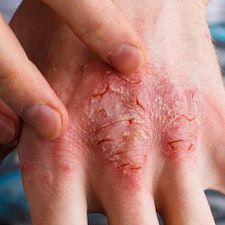Article
Antioxidants Safe and Effective for Atopic Dermatitis Management
Author(s):
Previous data suggests that lower antioxidant status in early life is associated with allergic status in childhood, which implies that antioxidant use could be beneficial in the management of atopic dermatitis.

A new investigation from China suggested that antioxidants could function as a safe and effective treatment for patients with atopic dermatitis, especially when supplemented with oral vitamin D and topical vitamin B12 .
Similar responses were recorded in pediatric patients with atopic dermatitis.
Previous epidemiological data suggested that lower antioxidant status in early life was associated with allergic status in childhood, which in turn suggested that antioxidant use could be beneficial in the management of atopic dermatitis.
Despite this, the results of these studies have been deemed controversial, as a comprehensive analysis regarding treatments with antioxidants was lacking.
With the present study, investigators led by Hua Wang, MD, PhD, Children’s Hospital of Chongqing Medical University, performed a meta-analysis that synthesized available efficacy and safety data of antioxidants in atopic dermatitis therapy to determine new therapeutic strategies.
Wang and colleagues searched the Drugbank database for supplements with antioxidant activity before conducting searches in Medline, Embase, and Cochrane Controlled Register of Trials (CENTRIL) from their inception to September 4, 2020.
A total of 169 antioxidants were identified, and all randomized controlled trials that compared antioxidants to placebo or no intervention in patients with atopic dermatitis were considered.
Changes from baseline in severity and itch score were extracted from all eligible studies and pooled via random-effects. A total of 18 trials were including in the study with a total of 763 eligible patients with atopic dermatitis.
Wang and colleagues observed that antioxidants were associated with statistically significant reductions in severity score compared with controls (P<0.0001), though significant heterogeneity was detected (I2 = 50%) (P = 0.003).
When analyzing 323 patients for a change in itch from baseline, investigators noted that no significant difference was seen between the antioxidant group and the control group (P=0.59), and heterogeneity was not significant (I2 = 4%; p = 0.41).
Notably, a subgroupanalysesfoundthatoralsupplementationwithvitaminD (VD)(P = 0.01), combinedVD and vitaminE(VE)(P = 0.003), combinedvitaminA, D, E (P = 0.02) and topicalvitaminB12 (VB12) (P < 0.0001) were associatedwithasignificantdecrease inseverityscore.
Antioxidants were also associated with a significant reduction in severity score in children (P=0.02), but no additional benefit was seen in adults.
Data regarding antioxidants in children were consistent with existing evidence, though investigators suggested that further research was needed in assessing antioxidants for the management of atopic dermatitis.
“The results of this meta-analysis support the favorable efficacy and safety of antioxidants for adjunctive AD therapy, especially when supplemented with oral VD and topical VB12 in pediatric patients,” the team wrote. “Further trials with more high quality and monitoring serum antioxidant levels or antioxidant capacity levels are needed.”
The study, “Efficacy and safety profile of antioxidants in the treatment of atopic dermatitis: A systematic review and meta-analysis of randomized controlled trials,” was published online in Dermatologic Therapy.





